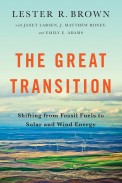Monday, December 06, 2010
In December, we take time to reflect on the year soon to pass. In this and a subsequent blog, I’d like to give you a sense of what we’ve accomplished this year.
Since its inception, Earth Policy Institute has worked to provide a roadmap—Plan B—for saving civilization. We continue to refine Plan B and to support it with the latest scientific data. Human behavior changes either in response to new information or new experience. We disseminate new information through various publications to guide the process of change. Our goal is to generate visibility and to build public support for global action to stabilize climate, stabilize population, and rebuild the economy’s natural support systems.
The Research Agenda
For about half of the year, our research team was consumed with the questions of how much time we have left before our global civilization unravels and how we save civilization. These questions led to a massive research effort fueling a new book, World on the Edge: How to Prevent Environmental and Economic Collapse by Lester Brown, which went to our publishers in late October for release in early January 2011.
The team also maintained a flow of Plan B Updates, Eco-Economy Indicators, Book Bytes, and Data Highlights. Two of the Plan B Updates were released at press teleconferences. The first, released in January, was on how the U.S. car fleet shrank by four million vehicles in 2009. Could America’s love affair with the automobile be coming to an end? Lester noted several reasons for this decline, including market saturation, ongoing urbanization, economic uncertainty, oil insecurity, the prospect of higher gasoline prices, the rising costs of traffic congestion, mounting concerns about climate change, and the declining interest in cars among young people who have grown up in cities. We were the first to note this shift, which led to a large number of global media reports.
The second Update was looking at how out of sync the natural world has become due to climate change. Janet Larsen noted that with climate change springtime is arriving earlier and altering the timing of key life-cycle events. Because species are adjusting at different rates, this is disrupting the dance that connects predator and prey, butterfly and blossom, fish and phytoplankton, and the entire web of life.
We responded to the Russian heat wave and fires with an Update in early August entitled “Rising Temperatures Raise Food Prices: Heat, Drought, and a Failed Harvest in Russia.” About 30 reporters were on the teleconference call, generating extensive media coverage including Time, OneWorld, The San Francisco Chronicle, Climate Progress, The Energy Bulletin, TreeHugger, The Moscow Times, Politico, Voice of America, and UPI. It also led to an AP feature in October on the global food situation.
Our research team also released Eco-Economy Indicators on global temperature (the past decade was the hottest on record, wind power (a record year for cumulative installed wind power capacity, and carbon emissions (an overall drop, even though emissions in China grew by nearly 9 percent.
The seven Data Highlights released thus far in 2010 sometimes garnered more press coverage than an Update or Indicator. For instance, the data highlight released on January 21, “U.S. Feeds One Quarter of its Grain to Cars While Hunger is on the Rise,” was reported on in over 75 online news sources. These highlights draw attention to the wealth of data available on the Institute’s website. Along this line, the team updated the popular PowerPoint Plan B presentation with Plan B 4.0 data and information.
The research team also released 26 Book Bytes gleaned from Plan B 4.0. These return considerable feedback and comments from readers and are reposted on websites as well as reprinted in magazines.
We are now prioritizing our research for 2011. You can help us keep this flow of important research moving with a tax-deductible donation.
Meanwhile, stay tuned!
Sincerely,
Reah Janise Kauffman
Vice President
Page 1 of 1 pages


